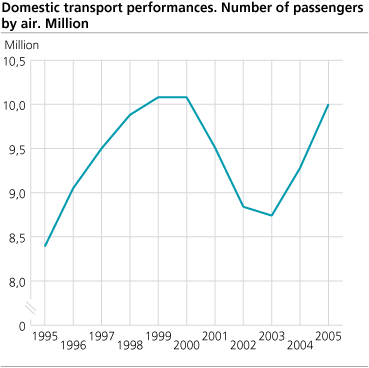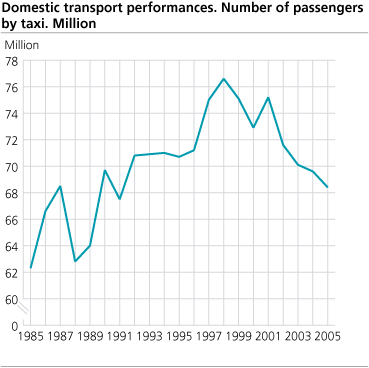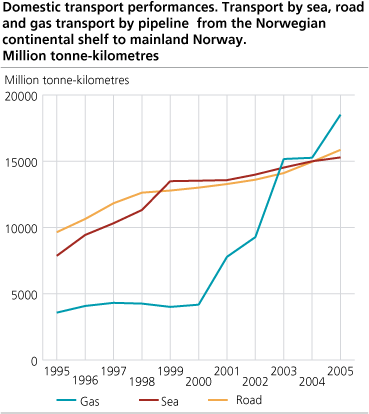Content
Published:
This is an archived release.
New growth for public transport
A total of 486 million passengers travelled by railway, suburban railway, urban tramways, scheduled road transport and air in 2005, an increase of 6 million passengers compared to 2004. The transport work for the public transport comprised 11.7 billion passenger kilometres, which is an increase of 360 million.
For the second year in a row there was an increase in the number of passengers on public transport, and the level in 2005 was almost as high as in 2000. The passengers transported by public transport increased by 21 per cent in the period 1990-1999. The growth continued in the next decade and reached a peak in 2001. 493 million passengers were transported this year. During the next couple of years the number of passengers transported by public means of transport declined.
Suburban railways and urban tramways had the most obvious variations in the number of passengers in the years after 2000. 105 million passengers were transported in 2001 - the highest number of passengers by suburban railways and urban tramways since 1967 (106 million) - and fell then to 91 million in 2004. In 2005 97 million passengers were transported by this means of public transport, an increase of almost 7 per cent compared to 2004.
| Domestic transport performances. Number of passengers and passenger kilometres. Million |
| passengers | passangerkm | ||||||||||||||||||||||||||||||||||||||
|---|---|---|---|---|---|---|---|---|---|---|---|---|---|---|---|---|---|---|---|---|---|---|---|---|---|---|---|---|---|---|---|---|---|---|---|---|---|---|---|
| 1990 | 1999 | 2000 | 2001 | 2002 | 2003 | 2004 | 2005 | 1990 | 1999 | 2000 | 2001 | 2002 | 2003 | 2004 | 2005 | ||||||||||||||||||||||||
| Railway | 34 | 54 | 55 | 54 | 50 | 50 | 51 | 52 | 2 011 | 2 909 | 2 857 | 2 764 | 2 491 | 2 420 | 2 634 | 2 685 | |||||||||||||||||||||||
| Suburban railways and urban tramways | 81 | 105 | 103 | 105 | 103 | 97 | 91 | 97 | 419 | 507 | 496 | 508 | 498 | 476 | 458 | 518 | |||||||||||||||||||||||
| Scheduled road transport | 278 | 316 | 320 | 324 | 319 | 321 | 329 | 327 | 3 890 | 4 177 | 4 141 | 4 105 | 4 125 | 4 005 | 4 231 | 4 380 | |||||||||||||||||||||||
| Air transport | 7 | 10 | 10 | 10 | 9 | 9 | 9 | 10 | 2 665 | 4 362 | 4 415 | 4 257 | 4 030 | 3 799 | 4 043 | 4 142 | |||||||||||||||||||||||
| Public transport, total | 400 | 485 | 488 | 493 | 481 | 477 | 480 | 486 | 8 985 | 11 955 | 11 909 | 11 634 | 11 144 | 10 700 | 11 366 | 11 725 | |||||||||||||||||||||||
| Private cars | 3 094 | 3 342 | 3 345 | 3 399 | 3 502 | 3 579 | 3 646 | 3 756 | 42 696 | 46 121 | 46 832 | 47 925 | 49 383 | 50 464 | 50 686 | 51 457 | |||||||||||||||||||||||
A new tailwind for the air transport
Following a continuous decline from 2001 to 2003, an upturn came in 2004 with an increase in the number of passengers transported of 7 per cent compared to 2003. Compared to 2004 the number of passengers transported in 2005 increased by 8 per cent. 10 million passengers were transported by air this year, i.e. almost the same level as for 1999 and 2000.
A new top rate for the private cars, but a decline for the transport by taxis
Almost 3.8 billion travels were made in private cars in 2005. The increase from 2004 to 2005 was 3 per cent. The private car constituted 51.5 billion passenger kilometres in 2005, an increase of 1.5 per cent compared to 2004.
Not surprisingly, the statistics show a considerable fluctuation in the use of taxis from one period of time to another. 68 million travels made by taxis in 2005 indicate a new period of recession for the taxi transport. A lower figure is to be found as far back as 1991 (67 million). Compared to 2004 and 2000, the decrease in 2005 was two million and five million passenger travels respectively.
Almost a triplication in forty years
The average Norwegian travelled 14 kilometres per day in 1965. In 2005 the average trip length had grown to 40 kilometres per day, an increase of almost 200 per cent. In the same period of time the daily distance we drive in average by private cars, had increased more than 300 per cent compared to an increase of only 40 per cent for the other means of transport in total.
|
Domestic transport performances. Number of passenger
kilometres per inhabitants per day |
| Total | Private cars | Other passenger tranport | Air | Railway1 | Water transport | ||||||||||||||||||||||||||||||||||
|---|---|---|---|---|---|---|---|---|---|---|---|---|---|---|---|---|---|---|---|---|---|---|---|---|---|---|---|---|---|---|---|---|---|---|---|---|---|---|---|
| 1946 | 4.04 | 0.93 | 0.88 | 0.00 | 1.83 | 0.40 | |||||||||||||||||||||||||||||||||
| 1952 | 5.67 | 1.31 | 2.04 | 0.01 | 1.86 | 0.45 | |||||||||||||||||||||||||||||||||
| 1960 | 9.72 | 3.65 | 3.51 | 0.08 | 1.99 | 0.49 | |||||||||||||||||||||||||||||||||
| 1965 | 13.89 | 7.43 | 3.93 | 0.25 | 1.78 | 0.50 | |||||||||||||||||||||||||||||||||
| 1970 | 18.32 | 12.61 | 3.44 | 0.45 | 1.37 | 0.45 | |||||||||||||||||||||||||||||||||
| 1975 | 24.14 | 17.99 | 3.45 | 0.70 | 1.55 | 0.45 | |||||||||||||||||||||||||||||||||
| 1980 | 27.29 | 20.41 | 3.61 | 0.99 | 1.84 | 0.44 | |||||||||||||||||||||||||||||||||
| 1985 | 31.44 | 24.34 | 3.57 | 1.42 | 1.69 | 0.42 | |||||||||||||||||||||||||||||||||
| 1990 | 34.81 | 27.58 | 3.49 | 1.72 | 1.57 | 0.45 | |||||||||||||||||||||||||||||||||
| 1995 | 35.28 | 27.44 | 3.49 | 2.24 | 1.68 | 0.43 | |||||||||||||||||||||||||||||||||
| 1996 | 39.74 | 28.27 | 3.81 | 2.46 | 1.74 | 0.46 | |||||||||||||||||||||||||||||||||
| 1997 | 36.90 | 27.92 | 4.15 | 2.51 | 1.83 | 0.49 | |||||||||||||||||||||||||||||||||
| 1998 | 37.73 | 28.30 | 4.41 | 2.62 | 1.89 | 0.51 | |||||||||||||||||||||||||||||||||
| 1999 | 37.91 | 28.11 | 4.49 | 2.68 | 2.10 | 0.53 | |||||||||||||||||||||||||||||||||
| 2000 | 38.43 | 28.57 | 4.60 | 2.70 | 2.04 | 0.52 | |||||||||||||||||||||||||||||||||
| 2001 | 38.63 | 29.08 | 4.47 | 2.58 | 1.99 | 0.51 | |||||||||||||||||||||||||||||||||
| 2002 | 38.98 | 29.81 | 4.42 | 2.43 | 1.80 | 0.52 | |||||||||||||||||||||||||||||||||
| 2003 | 39.11 | 30.29 | 4.29 | 2.28 | 1.74 | 0.51 | |||||||||||||||||||||||||||||||||
| 2004 | 39.33 | r30,24 | 4.35 | 2.41 | 1.83 | 0.50 | |||||||||||||||||||||||||||||||||
| 2005 | 39.71 | 30.49 | 4.37 | 2.45 | 1.90 | 0.50 | |||||||||||||||||||||||||||||||||
| 1 | Including suburban railways and urban tramways. |
The average length of transport of goods is still increasing
345 million tonnes were transported on the mainland in 2005, an increase of barely 1 per cent compared to 2000. The transport work, however, increased with 18 per cent in the same period of time. The reason for the differences in percentages can be explained by the continuous increase in the length of transport by lorry. The transport by lorry comprised 74 per cent of the total tonnes transported on the mainland in 2005. Thus, the average distance per tonne carried came to 50 kilometres in 2000, the average length had increased to 62 kilometres in 2005. From 2004 the average length by lorry had increased with 3 kilometres.
Still, the average length of transport of goods by lorry is far behind the average length performed by ships for hire or reward and on own account. These ships carried each tonne 445 kilometres in average. The transport by lorry is therefore not so dominating when the comparison is based on transport work rather than tonnes transported. 15.9 and 15.3 billion tonne-kilometres were performed in 2005 by lorries and by maritime transport respectively.
Gas transport by pipeline dominates
The transport of gas by pipeline from the Norwegian continental shelf to the Norwegian mainland, constitutes only one quarter of the tonnes transported by lorry or by sea, but measured in tonne- kilometres, the gas transport by pipelines dominates. 18.5 billion tonne-kilometres was performed by
this means of transport in 2005, an increase of 20 per cent compared to 2004.
The statistics show that the transport on the mainland still is considerably higher fthan the total transport of oil and gas from the continental shelf to the Norwegian mainland, measured in tonnes transported, with 345 and 118 million tonnes respectively in 2005. However, due to differences in the average length each tonne is transported, the difference in tonnes transported is almost balanced when the transport work is the basis for comparing. 33 and 32 billion tonne-kilometres were performed on the mainland and from the continental shelf to the Norwegian mainland in 2005.
Tables:
Contact
-
Geir Martin Pilskog
E-mail: geir.martin.pilskog@ssb.no
tel.: (+47) 40 81 13 83



